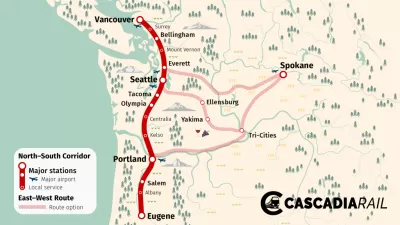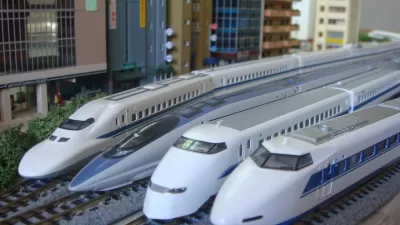Washington State released a report detailing the business case for connecting Seattle to Portland and Vancouver by high-speed rail.

The state of Washington released a report on economic impacts of a proposed high-speed rail (HSR) line connecting Vancouver, Seattle, and Portland. The report estimated that the line could bring 160,000 jobs to the Cascadia region and more than 350 billion new dollars in economic activity. "Drastically cutting travel time between the cities would also have the knock-on effect of drawing more companies to the region, which the report from the Washington State Department of Transportation argues would generate hundreds of billions of dollars in economic growth," Tyler Orton writes for Business in Vancouver. The new service could also curb emissions if it could tempt car and air commuters to use the train. The report estimates the project would eliminate 6 million tons of carbon emissions.
The planned train would travel at just under 200 miles per hour and be faster than any train service currently operating in the United States. Still, the Cascadia HSR is in the early planning phase. The proposed train does not currently have a route, and past attempts at HSR in the United States have failed to reach the speeds initially touted by boosters.
Even so, the report funded by the governments of British Colombia, Washington, Oregon, and the Microsoft Company does achieve a positive effect for the project. In 2017, the cost of the project was estimated to fall between $24 billion and 42 billion. The report says that estimate is still feasible.
FULL STORY: Vancouver-Seattle-Portland high-speed rail zips closer to reality with new business case

Alabama: Trump Terminates Settlements for Black Communities Harmed By Raw Sewage
Trump deemed the landmark civil rights agreement “illegal DEI and environmental justice policy.”

Planetizen Federal Action Tracker
A weekly monitor of how Trump’s orders and actions are impacting planners and planning in America.

The 120 Year Old Tiny Home Villages That Sheltered San Francisco’s Earthquake Refugees
More than a century ago, San Francisco mobilized to house thousands of residents displaced by the 1906 earthquake. Could their strategy offer a model for the present?

In Both Crashes and Crime, Public Transportation is Far Safer than Driving
Contrary to popular assumptions, public transportation has far lower crash and crime rates than automobile travel. For safer communities, improve and encourage transit travel.

Report: Zoning Reforms Should Complement Nashville’s Ambitious Transit Plan
Without reform, restrictive zoning codes will limit the impact of the city’s planned transit expansion and could exclude some of the residents who depend on transit the most.

Judge Orders Release of Frozen IRA, IIJA Funding
The decision is a victory for environmental groups who charged that freezing funds for critical infrastructure and disaster response programs caused “real and irreparable harm” to communities.
Urban Design for Planners 1: Software Tools
This six-course series explores essential urban design concepts using open source software and equips planners with the tools they need to participate fully in the urban design process.
Planning for Universal Design
Learn the tools for implementing Universal Design in planning regulations.
Clanton & Associates, Inc.
Jessamine County Fiscal Court
Institute for Housing and Urban Development Studies (IHS)
City of Grandview
Harvard GSD Executive Education
Toledo-Lucas County Plan Commissions
Salt Lake City
NYU Wagner Graduate School of Public Service





























